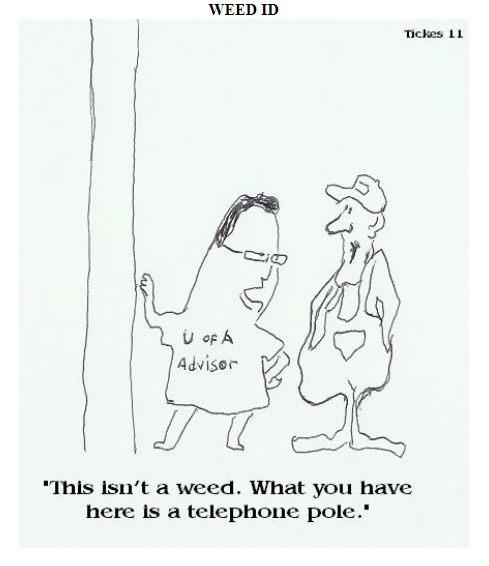Increasingly sophisticated equipment has made pesticide application more precise now than ever before. Knowledge of the exact spray volume is the basis for accurate applications. Spray volume is determined by three variables: speed, pressure and nozzle output and many techniques and formulas are available for calculating spray mix when these variables are known. Most of the newer equipment used for commercial applications contain computers that make these calculations for you. Precision rapidly goes downhill, however, when people put on a backpack sprayer to selectively spot spray weeds in and around fields.
When making spot applications by hand only one of the 3 important variables needed to accurately calibrate the sprayer, nozzle output, is often known. Speed is often zero as the person doing the spraying stops at each weed or patch of weeds and pressure is often unknown as the applicator uses a hand crank to pump it up. A pressure gauge can be installed but rarely is.
It is always best to calibrate the sprayer as precisely as possible although in practice this can be very difficult. It is necessary, however, to get at least a general idea of spray volume when applying herbicides. Herbicide labels and nozzle charts can be very helpful.
Many herbicide labels address the subject of spot spraying with hand sprayers and give guidelines on how to do this. A few examples are:
Goal: Apply uniformly to soil for preemergence weed control...and spray-to-wet basis for post emergence weed control.
The amount required to treat 1000 square feet for specific rates are listed.
Gramoxone: If the broadcast rate per acre is (chart) add the following amount of Gramoxone Inteon to one gallon of water.
Roundup: Chart lists the amount to add to a certain volume of water, from one gallon to 100 gallons, in order to apply a certain percentage of herbicide. Spray coverage should be uniform and complete…applications made on a spray-to-wet basis. Do not apply to point of runoff.
Many other herbicide labels contain guidelines on spot spraying but many do not. Nozzle charts can also be helpful. Nozzle type and size determine the spray volume, uniformity of application, spray pattern, surface coverage and other important factors. There are several general types of spray nozzles used in agriculture. Flat fan, flood, hollow cone and solid cone are the most common. Flat fans are most commonly used to apply herbicides. These produce a flat ever spray. There are several sub types such as standard flat fan, even flat fan, low pressure flat fan and extended flat fan. Floodnozzles are used mainly for applying suspension fertilizers where clogging is a potential problem. These produce large droplets and are generally not suited for herbicide applications. Hollow cones have a round orifice and produce a cone shaped pattern. These are generally used to apply insecticides or fungicides where complete coverage and penetration of the foliage is required and are generally not used for herbicides. Solid cone nozzles produce a wider angle and bigger droplets. They are sometimes used for soil incorporated herbicides.
Once the nozzle type is selected, you can use a chart that lists spray volumes produced at certain pressures and speeds. There are several spray nozzle manufacturers although the two that are most common are The Spraying Systems Company (Tee Jet) and Delavan-Delta Inc. Tee Jet is most common in this area.
A spray volume of 20 -30 gallons per acre is typical for herbicide applications. Foliar contact and soil applied herbicides (Gramoxone, Aim, Buctril Prowl) generally work best at higher spray volumes while systemic foliar applied herbicides (Glyphosate, Poast, Clarity) work best at lighter even volumes. If pressure and speed are unknown, the applicator should try to simulate the coverage that would be produced from a ground application made by a sprayer set to apply this volume. This is a light even application. Something between a mist and a drench may be the most precise way to describe it. Herbicide labels often describe this as spray-to-wet
.
Flat fan nozzles are available in several spray angles. The most common are 80 and 110 degrees. The angle will affect the proper height between the nozzle and the target. 110 degree nozzles are designed for lower heights and the 80 degree nozzles for higher boom heights.
Once the spray volume is estimated, it is possible to calculate how much herbicide to put in the tank. You just multiply the application rate by the amount being mixed and divide this by the spray volume. For example, if the desired rate is 2 pints per acre, the expected spray volume is 20 gallons per acre and you want to mix one gallon, you multiply 2 pints by 1 gallon and divide this by 20. In this example, you would add 0.1 pint (1.6 oz) to 1 gallon of water.








